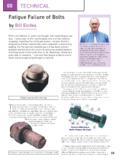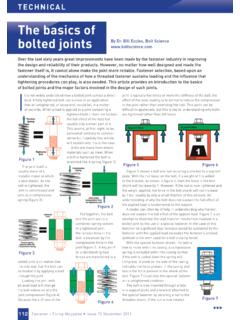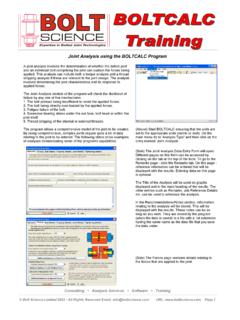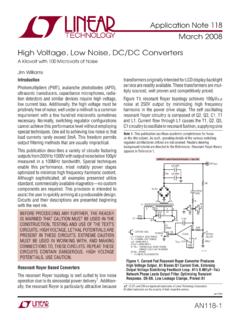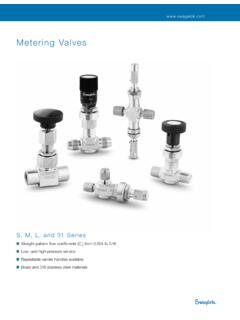Transcription of Article on Fatigue Failure of Bolts - Bolt Science
1 00 TECHNICAL. Fatigue Failure of Bolts by Bill Eccles Within my lifetime, it used to be thought that metal Fatigue was due, in some way, to the metallurgical nature of the material changing. Somehow the metal got weaker, became tired ( fatigued) and failed prematurely when subjected to alternating Bill Eccles is a Chartered Engineer and loading. For the last two hundred years it has been a known formed his company bolt Science some 12 years ago to specialise in problem and has been the cause of numerous product failures bolting technology. The company including some involving the loss of life. Nowadays, following a writes and markets bolted joint analysis great deal of research, it is known that Fatigue is due to one or software together with completing consultancy assignments and training more cracks progressing through a material.
2 Courses. Further information is available from Bill via email or from the website at The term Fatigue damage is frequently used to describe the damage to a part that has been sustained as a result of loading. Such Fatigue damage is nowadays equated to crack length. In some critical applications there is a requirement that Bolts are periodically crack detected using dye penetrant or even by x-rays to ensure that there are no detectable cracks present. (Cracks may be present on the microscopic scale, that is, below the detection threshold of the measurement technique.). The purpose of this Article is to provide some examples of ways in which the design and manufacture of Bolts can affect their Fatigue performance. Fatigue Failure of nuts is practically unknown since Fatigue cracks propagate as a result of a Fatigue is progressive cracking fluctuating tensile stress - nuts are under a compressive stress and so any pre-existing cracks tend not to propagate.
3 He crack can start at some existing defect, such as an T inclusion in the metal , or at point of high stress, such as a notch, and slowly grow in length at each loading. It may take millions of loadings and unloadings (known as load or stress cycles) before the crack is actually detectable . As the length of the crack increases, the material remaining is placed under increasing stress because there is less area to sustain the loading. When the crack actually reaches a critical length it progresses all the way through the material resulting in complete Failure . 1. The quality of the surface finish of the threads is known to have an effect on Fatigue life: the smoother the surface, the higher is the Fatigue life. Hence in general terms, threads that are rolled have a higher Fatigue life than a thread that has been cut.
4 2. Fatigue cracks usually initiate in the roots of the threads, this is due to this region being highly stressed because of the local change in section (a so-called stress concentration). Thread A Fatigue crack can take years to progress through a bolt rolling AFTER heat treatment induces localised compressive stresses in the thread roots. These compressive stresses help to . 00 TECHNICAL. prevent crack initiation and hence improve the Fatigue life. Rolling the threads before heat treatment does not give the same 5. With Fatigue there is a size effect, the larger the part - the lower is the Fatigue strength, given the same stresses. This applies benefit since the compressive stresses are flushed out with the to bolt threads and the effect is shown in the diagram. heat treatment operation. Rolling after heat treatment can offer a significant improvement.
5 Bolts with threads rolled after heat 6. Fatigue cracks usually initiate in the thread roots but can treatment can have double the Fatigue strength compared with also initiate under the bolt head. Often Failure in this location is ground threads. Although rolling after heat treatment can offer the result of an inadequate under head radius (resulting in a high significant improvements from a design aspect, it is pretty dire stress concentration) or the bolt being mounted on an inclined from a manufacturing cost standpoint. The higher hardness of the surface. A small joint angle (such as two degrees) can have a dire threads significantly increases wear on the rolls resulting in a effect on Fatigue strength. This effect has caused many a service lower useful life. Effectively this results in Bolts with threads problem in the past; a comparatively common problem when rolled after heat treatment being more expensive to produce.
6 (On bolting welded structures together. large diameter threads, inducing compressive stresses in the thread roots to improve Fatigue strength has been achieved by shot peening.). 3. Tests have shown that having the nut face too close to the thread run-out region of the thread can result in premature Failure . The thread run-out region is usually poorly formed and is hence an area of stress concentration. The highest stressed thread is the first one in the nut; having this region in close proximity to the thread run-out results in a Fatigue strength reduction. Having a distance of two or more thread pitches from the nut face to the thread run-out eliminates this effect. 7. The load distribution in a nut is not even, the majority of the load is taken by the first few threads. As a result, the majority of Fatigue failures in fasteners occur in the thread just under the nut.
7 Any changes that can be made to produce a more even load distribution in the nut will improve the Fatigue strength. 8. It has been known for a long time that the use of an asymmetric thread profile can improve the Fatigue life as a result of it providing a more even load distribution in the nut. The most common asymmetric profile in present use is the Spiralock thread that is applied to the nut thread and is used with a standard bolt thread (thread inserts with the Spiralock profile are available). SPS. Technologies also have an asymmetric thread profile that has been quoted to provide a 20% improvement in the bolt Fatigue 4. By increasing the size of the root radius, the stress life. concentration is reduced, and the Fatigue strength improved. Thread profiles having a larger root radius than normal (such as 9.)
8 On the theme of improving the load distribution in the nut MJ threads used for aerospace applications) are used were to improve the Fatigue life of the nut, one study reported on an Fatigue resistance is paramount. MJ threads have a minimum root investigation to change the nut profile. By placing a groove near radius of p (where p is the thread pitch) compared to the face of the nut and making the nut face concaved an p for standard metric threads. (Increasing the radius above improvement in the Fatigue life of 25% was reported. This p - the maximum for the MJ profile can result in approach has been used to improve the Fatigue life of very large interference with the nut thread profile.) diameter Bolts . Other approaches to give a more even load distribution that have been used are: to use a nut made from a material with a different modulus of elasticity to the bolt ; to have a difference in pitch between the bolt and nut threads; and to use a tapered thread.
9 10. In the vast majority of applications, the most effective way to ensure that the bolt is Fatigue resistant is to ensure that it is tightened sufficiently. A preloaded bolt in a typical joint sustains usually only around 5% (or less) of the applied loading (the remaining 95% reduces the clamp force acting on the joint). Due to this, a properly tightened bolt is highly resistant to Fatigue loading. (A conn-rod bolt for example would rapidly fail if it were not tightened.) Because the alternating load is small, so is the alternating stress, usually well below the bolt 's endurance limit. Fatigue failures, when they do occur, are frequently the result of inadequate tightening or loosening that can expose the bolt to bending stresses that it is not designed to sustain.
